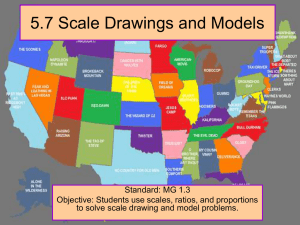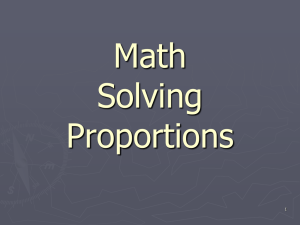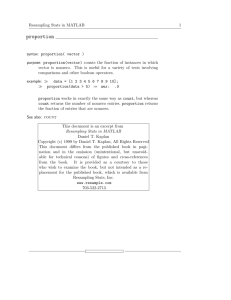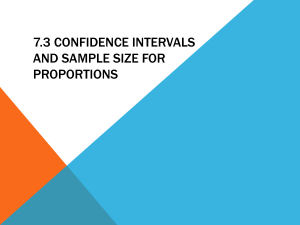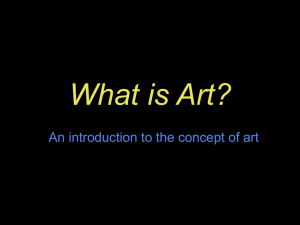Rethinking Resource Sharing
advertisement
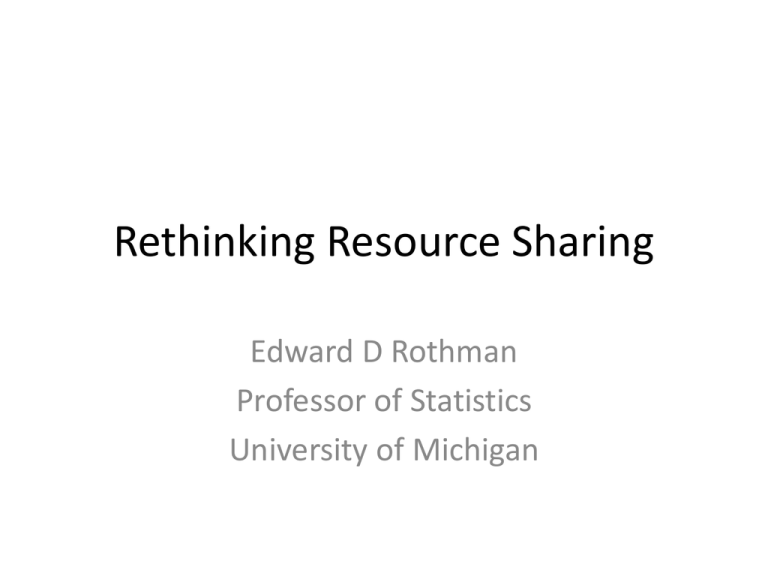
Rethinking Resource Sharing Edward D Rothman Professor of Statistics University of Michigan W Edward Deming • 1900-1993 • American Statistician • Contributions included a transformation of the Japanese automobile industry from low quality to high quality • See the white paper “If Japan can why can’t we….” 1981 on NBC System Thinking • A collection of components that come together repeatedly for a purpose • Our job is the achieve the purpose • This requires an ability to plan to meet customers needs and wants and to act • The key is a useful theory and action based on the theory. Why do we need this? • Many standard approaches to management place emphasis on aspects of the system. • For instance, measurement, MBO, and work standards are designed to make us more efficient. • Principle: High efficiency may not be an effective way to move us forward. For Anne Gregory-W.B. Yeats • • • • • • • Interrogator: “Never shall a young man, Thrown into despair By those great honey-coloured Ramparts at your ear, Love you for yourself alone And not your yellow hair.” And Anne Gregory replies, • • • • • • “But I can get a hair-dye And set such colour there, Brown, or black, or carrot, That young men in despair May love me for myself alone And not my yellow hair.” Interrogator Responds: • • • • • • “I heard an old religious man But yesterday declare That he had found a text to prove That only God, my dear, Could love you for yourself alone And not your yellow hair.” Example 500/hour 200/hour Customer Optimization Means Achieve the Purpose • In the last example, we want to have high throughput yet little work in process (W.I.P.) • Operate step 1 at 40% efficiency. • Look at the rate limiting step---move this to a higher level if the customer demands more. • Recognize that those steps that do not limit throughput, have excess capacity. What other uses can we make of step 1? Purpose • The purpose of the system is an assertion that represents a win for everyone. • By everyone we mean suppliers, people in the process and customers. • We measure success by looking at how we move towards achievement of the purpose. • Principle: Optimization of a measurement can be suboptimal for the system. First Steps • Identify the participants • Learn the needs and wants of each party • For each participant, ask why again and again… • Find the purpose • Example: Your 14 year old daughter wants to attend a party at a friends house. Seeks permission to return at midnight. Dad wants her home at 10 PM. Mission=Purpose • To (expand and promote---to provide information---) information accessibility to the …….community The Learning Process • The system design must recognize variation. Seek robust methods—those that work well under a wide variety of circumstances—but also understand the need to adapt and change. • Deming Learning Cycle-Plan-Do-Study-Act • Rothman-Rabkin: IPCAR—Imagine, Predict, Choose, Act, Review Voice of the Customer • Many systems fail when we allow the least informed to move us from step to step. • The customer usually knows least about the process. • However, they can describe features of the ideal process. (e.g. wait time for service) • What features of the process can they help us understand? Principles • In responding to the voice of the customer make sure we understand the implications. • Ex. A hospital clinic adds examining rooms to reduce patients wait time in the clinic entryway. • Use a Pareto chart to identify the most common issue or the most painful issue. Work on these priorities first. Voice of the Process • You define the process and should highlight features that are important to the customer • Language is a key element— – You need operational definitions of all measurements, there is no true value – The language you use internally may differ from the customers language • Measurements are used to focus attention on aspects of the process Some Principles • Attempt to move upstream in the process rather than focus on symptoms. (Ask why again and again…) • The solution is often at the interface of the units, people, departments…. and not within these areas. • Technology is nice but often opportunities are found that cost little and deliver much. Measurement System • Must be aligned with the process purpose – Consider that a grade point average creates a distinct purpose – • The measurement is a model of the system— just as a photo is a reflection of only aspects of the subject. – It is possible to improve the measurement at the expense of the process. – When an improvement in the measure is observed ask “What was done?” Measurements • Outcomes such as time to deliver • Predictors—Outcomes are too late and too expensive to change—we need to move upstream to make improvements • Time –order-spatial data to learn about stability • Stratifying variables—related to outcomes and to the groups compared Time-Order • Most systems are such that even when the inputs are fixed, the outputs vary. For instance, not every request will be met in exactly the same number of hours. • When the proportion of outcomes of a certain type remain the same from day to day—the process is said to be stable. • The question you ask depends on whether a system is stable! Common Cause • When a system is stable ask- What is the common cause of the variation? • When a system is unstable ask—What is the special cause of the event? • Example: A child spills milk….. • The way we decide whether a system is stable is by plotting the values against time or order. Stratifying Variables • Average days to completion of request for two libraries: • A: 3 days • B: 4 days • Is it possible that B always provides faster service than A? Strata • Stratum I • A: 2 days proportion 5 of 6 • B: 1 day proportion 1 of 4 • Stratum II • A: 8 days proportion 1 of 6 • B: 5 days proportion 3 of 4 Learning Culture • Will Rodgers once said; “even if you’re on the right track, you’ll get run over if you just sit there.” • Beware of leaning disabilities –”I am my position”, “the enemy is out there”, “fixation on events”, “politics makes sameness an asset” • Don’t engage in wack-a-mole • Avoid benchmarking, numerical goals without a plan, and competition between units (people).. Thanks You • Questions?




